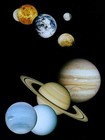
'MARS' WITH ITS RELENTLESS, AGGRESSIVE MARTIAL RHYTHM AND OMINOUS HARMONIES IS SYMBOLIC OF THE BRUTALITIES OF WAR. THIS IS THE 1ST MOVEMENT IN 'THE PLANETS', THE EPIC 7 PART SUITE WRITTEN BY GUSTAV HOLST (1916). PERFORMED BY THE USAF GOLDEN WEST BAND
highschool bands
jazz bands
college bands
all region bands
community bands
concert bands
honor bands
interlochen arts academy
marching bands
national music camp
tmea all state bands
university bands
Story behind the song
"Mars", obviously, is based on war. The quiet but menacing 5/4 in the beginning symbolizes gathering troops and mounting tension. When the full force of the fanfare is released, it is obviously symbolic of brutal war. The baleful euphonium solo about a third of the way through tells the tale of a carefully planned attack from one side, which, for all its military excellence, is crushed.
The Planets Suite was, by far, Holst's largest orchestral work--a suite of seven unique movements, lasting upwards of 50 minutes when performed. Work on this composition of monumental scope began early in 1914 and was completed in 1916. The first complete public performance of The Planets was held on November 15, 1920. The suite's success was unrivalled , and has remained so to this day. Surprisingly, Holst was most dismayed by the international popularity of The Planets--it was his first and only composition to reach such a wide audience, and he thought of it as very atypical of his composition style; not Holstian, and he regretted it. He once wrote, "Every artist ought to pray that he may not be 'a success'." It is sad that such a great work of art, loved the world over, was resented by its own creator to his dying day simply because it was "too good."
The creativity used to write such a unique, one-of-a-kind piece is immeasurable. Many of the movements, Mars and Saturn in particular, were the first of their kind anywhere--true originals. Almost all of the movements have sparked other composers to do take-offs from them. We hear several movements everyday in the form of theme songs, on TV, movies, or the radio, even though we are unaware of them..
Gustav Holst seemed to consider The Planets a progression of life. "Mars" perhaps serves as a rocky and tormenting beginning. In fact, some have called this movement the most devastaing piece of music ever written! "Venus" seems to provide an answer to "Mars," it's title as "the bringer of peace," helps aid that claim. "Mercury" can be thought of as the messenger between our world and the other worlds. Perhaps "Jupiter" represents the "prime" of life, even with the overplayed central melody, which was later arranged to the words of "I vow to thee, my country." "Saturn" can be viewed as indicative of Holst's later mature style, and indeed it is recorded that Holst preferred this movement to all others in the suite. Through "Saturn" it can be said that old age is not always peaceful and happy. The movement may display the ongoing struggle for life against the odd supernatural forces. This notion mat be somewhat outlandish, but the music seems to lend credence to this. "Saturn" is followed by "Uranus, the Magician," a quirky scherzo displaying a robust musical climax before the tranquility of the female choir in "Neptune" enchants the audience.
The piece displays that Holst was in touch with his musical contemporaries. There are obvious ideas borrowed from Schoenberg, Stravinsky, and Debussy (the quality of"Neptune" resembles earlier Debussy piano music.) Holst never wrote another piece like The Planets again. He hated its popularity. When people would ask for his autograph, he gave them a typed sheet of paper that stated that he didn't give out autographs. The public seemed to demand of him more music like The Planets, and his later music seemed to disappoint them. In fact, after writing the piece, he swore off his belief in astrology, though until the end of his life he cast his friends horoscopes. How ironic that the piece that made his name famous throughout the world brought him the least joy in the end.
Holst brings us face to face with the horror of war in the most-famous movement in the Planets suite. Part of this will sound familiar to science fiction fans as there have been variations of this piece in various films. The relentless and aggressive march in 5/4 time evokes the martial rhythm of military drums and underscores the menacing melody. Ample use of GPO brass instrume